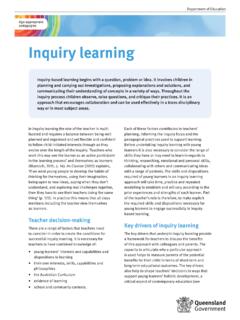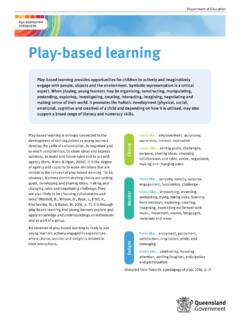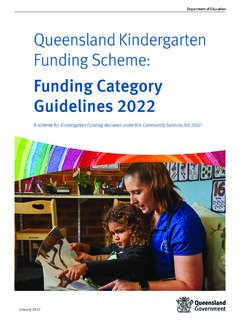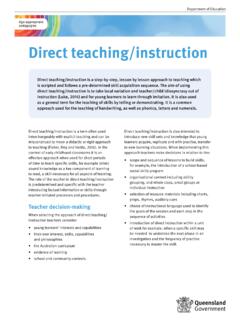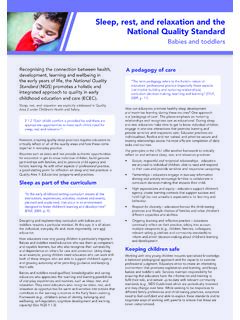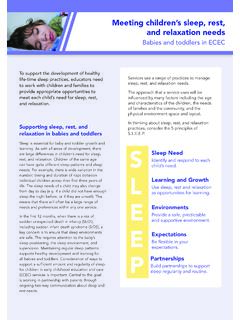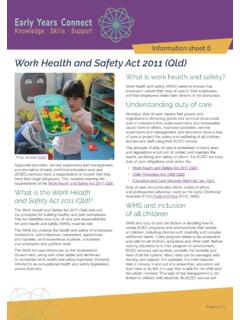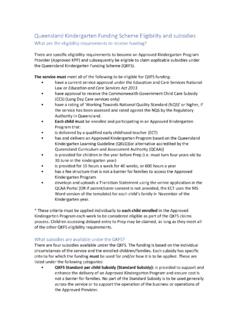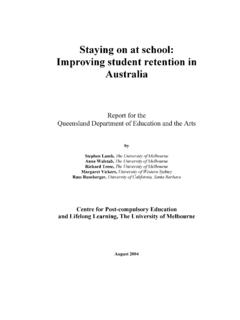Transcription of Embedding Aboriginal and Torres Strait Islander ...
1 Embedding Aboriginal and Torres Strait Islander Perspectives in schoolsA guide for school learning communitiesTomorrow s Queensland: strong, green, smart, healthy and fair2 Embedding Aboriginal and Torres Strait Islander Perspectives in Schools3 Minister s message.. 7 Acknowledgments .. 8 The context for change.. 9 The EATSIPS framework: An overview..10 Section 1 What is EATSIPS? 13 Aims of the EATSIPS guide..13 Embedding the Aboriginal and Torres Strait Islander Perspectives framework ..13 school leadership and educational leadership ..15 Section 2 The EATSIPS framework 17 Components ..17 Benefi ts..17 Whole- school ethos ..17 Planning processes ..18 Section 3 What are Aboriginal and Torres Strait Islander perspectives? 21 Defi ning perspectives ..21 Rethinking perspectives ..22 Personal histories ..22 Attitudes and perceptions ..24 Section 4 Whole- school ethos 27 Professional and personal accountabilities.
2 28 Curriculum and pedagogy ..29 Organisational environment ..30 Community engagement ..32 ContentsEmbedding Aboriginal and Torres Strait Islander Perspectives in Schools45 Section 5 Classroom ethos 35 Curriculum and pedagogy in the classroom ..35 Planning and developing curriculum materials ..35 Professional and personal accountabilities ..38 Awareness of your organisational environment ..38 Assessment and reporting ..39 Understanding Aboriginal and Torres Strait Islander knowledge frameworks ..39 Understanding your students and their community ..40 Developing strong community partnerships ..40 Understanding language and appropriate language use ..41 Understanding Aboriginal and Torres Strait Islander protocols ..43 Critical understanding and review of texts ..43 Section 6 Planning with EATSIPS 45 CASE STUDY/EATSIPS in action: One secondary school s journey,Rockhampton State High school ..45 CASE STUDY/EATSIPS in action: One primary school s journey,Marsden State school .
3 47 CASE STUDY/EATSIPS in action: One teacher s practice,Loganlea State High school ..48 Section 7 Measuring change: The implementation process 53 The implementation process a strategy for improving outcomes ..53 How to implement EATSIPS ..56 Actioning EATSIPS ..59 Appendices ..61 Appendix 1 Resources ..61 Appendix 2 Strategies for Embedding Aboriginal and Torres Strait Islanderperspectives in curriculum and pedagogy ..63 Appendix 3 Strategies for Embedding Aboriginal and Torres Strait Islanderperspectives in the school s organisational environment..67 References..72 Embedding Aboriginal and Torres Strait Islander Perspectives in Schools67 Aboriginal and Torres Strait Islander history, language and culture are integral to our national identity. There are more than 455 028 Aboriginal and Torres Strait Islander people in Australia. Some 28 per cent of people who identify as Aboriginal or Torres Strait Islander or both Aboriginal and Torres Strait Islander origin (127 580 people) live in Queensland.
4 Aboriginal and Torres Strait Islander students represent per cent of state school students within Queensland. Many of these Indigenous students arrive at school speaking their home language, which could be Aboriginal English or a Creole, and even one or more Indigenous languages or a combination of these (MCEETYA 2006, p. 17). Standard Australian English is not the home language of many Indigenous students . This mismatch between home and school language has directly impacted on Indigenous students achievement in literacy and numeracy in the long term (MCEETYA 2004; Warren and de Vries 2008).Although over the past 20 years progress has been made in the participation, retention and completion rates of Indigenous students within Queensland schools, current statistics demonstrate that Indigenous students still are not succeeding at the same rate as non-Indigenous students within various educational priority areas. Embedding Aboriginal and Torres Strait Islander perspectives in schools is a key action for the department under The Queensland Government Reconciliation Action Plan, released in June 2009.
5 Implementing this initiative will help to close the gap between Indigenous and non-Indigenous Australians in life expectancy, educational achievement and economic opportunity. It is also a key priority of the national Aboriginal and Torres Strait Islander Education Action Plan 2010 2014 which was endorsed by education ministers in each state and territory in April 2010. The Action Plan outlines actions that will be undertaken at the national, state and local level. A key systemic level action is that: Education providers will deliver professional learning to teachers to ensure high levels of cultural and linguistic understanding and competencies to inform the best teaching strategies for Aboriginal and Torres Strait Islander students .The EATSIPS guide focuses on systemic change, and personal and professional accountability when incorporating Indigenous perspectives into our school culture, curriculum and pedagogy. It aims to further equip our school leaders and teachers with more in-depth knowledge, understanding and skills to teach Indigenous and non-Indigenous students with confi dence and without prejudice.
6 Schools are able to broaden their understanding of Aboriginal and Torres Strait Islander perspectives through implementing a whole-of- school strategy in a way that refl ects on the past, responds to the present and creates systemic change for the future. Student and community engagement in learning are key drivers of Indigenous academic achievement, so the guide also aims to strengthen partnerships between school staff and local Indigenous communities, supporting inclusive education and improving the educational outcomes of Aboriginal and Torres Strait Islander students . The Embedding Aboriginal and Torres Strait Islander Perspectives in schools (EATSIPS) guide is a living document that can be accessed in both hard copy and online. As we live in a world that is constantly changing, the department commits to reviewing the document every two years to ensure the content is kept up-to-date and Wilson MPMinister for Education and Training Minister s messageGffWilMP8 Embedding Aboriginal and Torres Strait Islander Perspectives in Schools8 Warning: This guide may contain the names and images of Aboriginal and Torres Strait Islander people now deceased.
7 It also contains links to sites that may use images of Aboriginal and Torres Strait Islander people now EATSIPS guide and materials are made possible through the efforts and contributions of many people over a long period of time, especially the *Indigenous community members from across the state who continually provide an enormous amount of advice and direction to Queensland schools.*The term Indigenous is used throughout this document to describe Aboriginal peoples and Torres Strait Islander peoples of Australia. Indigenous means belonging naturally to a place ; this acknowledges Aboriginal and Torres Strait Islander peoples as the fi rst peoples of do schools need to change?An understanding of and respect for Australia s Indigenous peoples their personal histories, beliefs and values, languages and lifestyles is important in many ways. Research tells us that it helps when, as educators, we meet the educational needs of our Indigenous students in very practical ways we can improve attendance, retention and workplace participation.
8 Weaving the Indigenous story into the fabric of education through teaching about Indigenous cultures and perspectives in schools has been identifi ed nationally as key to improving outcomes for Indigenous Aboriginal and Torres Strait Islander perspectives will enhance the educational experiences of non-Indigenous students as will not only give them a more accurate and richer understanding of Australia s history and culture, it will help them to understand how we got to where we are today; and how we might move forward together. It s about , students , parents and principals we all bring our own perspectives, our own ways of seeing the world, through the school gate. Indigenous and non-Indigenous we all bring our share of cultural baggage ; our assumptions about the other . Some of our histories are separate and culturally unique, while some of our histories are is a call for educators and institutions to build bridges between the Indigenous and Western knowledge systems to achieve meaningful outcomes, for Indigenous students in particular but for all students in general.
9 The challenge still remains: how does one build bridges between the Western scientifi c and disciplinary knowledge and the Indigenous responsive, active eco-logical knowledge that views language, land, and identity as interdependent in a unique way and constantly renewed and reconfi gured (Williamson & Dalal, Christie cited in Klenowski 2008, p. 11).It is important for us to acknowledge and respect each others perspectives our ways of seeing the world and to fi nd that place where we can all meet, grow and learn. Perhaps the response to this challenge is the creation of the third cultural space. The third cultural space recognises that Indigenous communities have distinct and deep cultural and world views views that differ from those found in most Western education systems. When Western and Indigenous systems are acknowledged and valued equally, the overlapping or merging of views represents a new way of the diagram that follows, the black circle represents Indigenous ways of knowing, being and doing, and the red circle represents Western ways.
10 The middle yellow overlapping circle is the third cultural context for changeThe yellow centre represents spaces of not knowing third cultural space of innovation and by J Davis (2008). The third cultural spaceThe third cultural space process draws on the rich Aboriginal and Torres Strait Islander histories; perspectives; ways of knowing, being and doing (Martin 2009), balanced symbiotically alongside Western ways of knowing, being and doing. The middle ground or the third cultural space represents a new way of working (Bhahba 2004; Yunipingu 1989). Embedding Aboriginal and Torres Strait Islander Perspectives in Schools: A guide for school learning communities presents a framework or blueprint for supporting change in schools regarding education. It is about a change in thinking. It describes a way to create a cultural space that is shared and rich in the histories of Indigenous peoples. 10In 2004, the Embedding Aboriginal and Torres Strait Islander Perspectives in schools: P 12 school Guidelines for Administrators and Educators, a building block in Partners for Success (EATSIPS), was launched during NAIDOC Week.
